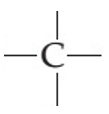

The article Carbon Chemical Formula will discuss the formula for carbon, a colorless acid gas. The carbon dioxide molecule consists of a carbon atom bonded with two oxygen atoms through covalent double bonds.
This gas is released during aerobic respiration. C is the chemical symbol for carbon, an element in group 14 of the periodic table and O is short for Oxygen. The bond length between carbon and oxygen measures 116.3 pm. In water, carbon dioxide becomes soluble and forms carbonic acid. Its molecular configuration is 1s 2 2s 2 2p 2 . Carbon dioxide takes on hexagonal or face-centered diamond cubic structures.
The compound with atomic number 6 is known as diamond and graphite. Carbon is abundant in the human body along with oxygen, making him the fourth most abundant chemical in the universe. The element has a configuration of 1s 2 2s 2 2p 2 and is the 6th element of the periodic table.
Carbon Structural Formula
The structural formula of carbon is shown below. Carbon is a nonmetallic and tetravalent compound that can accommodate 4 electrons to form a covalent bond. When it comes to forming covalent bonds with other atoms and carbon atoms, carbon is capable of establishing multiple stable bondings with suitable multivalent atoms.

What is the Chemical Formula of Carbon Dioxide?
What is the chemical formula for carbon? It has an atomic number of 6 and is a tetravalent non-metallic compound that readily forms covalent bonds by accepting four electrons. This allows for the creation of multiple stable covalent bonds with other atoms. Two well-known forms of carbon found in nature are diamond and graphite, which are abundant in living organisms alongside oxygen. Carbon dioxide (CO 2 ) is one of the most potent chemicals on a larger scale. As the sixth element on the periodic table, it is represented by CO 2 as its formula. When encountered, carbon dioxide has a distinct sour odor and tastes similar to soda water in your mouth.
Also Check – Potassium Cyanide formula
Characteristics of Carbon
Carbon has the following characteristics:
- Covalent bonds are formed when carbon makes 4 electrons.
- Allotropes and other forms of existence exist, including diamond and graphite.
- C is the symbol for carbon, a chemical element that is highly unreactive under normal conditions.
- Atomic number 6 refers to the number of protons in its nucleus.
- It comes in a variety of shapes and is both nonmetallic and tetravalent.
- Multiple elements can bond with the chemical element.
Also Check – Periodic Acid Formula
Chemical Properties
Carbon has the following chemical properties:
- Carbon has an atomic number of 6.
- Carbon has an atomic mass of 12.011 grams per mol.
- Carbon atoms have an electronegativity of 2.5. Their density at 20°C is 2.2 g.cm-3.
- Carbon has a melting point of 3652 °C and a boiling point of 4827 °C.
- 091 nm is the Van der Waals radius.
- A carbon atom has an ionic radius of 0.015 nm (+4) and 0.26 nm (-4).
- The first, second, and third ionisations of the carbon atom have energies of 1086.1 kJ.mol-1, 2351.9 kJ.mol-1, and 4618.8 kJ.mol-1, respectively.
- Antoine Lavoisier discovered the carbon atom.
Also Check – Lithium Oxide Formula
Applications of Carbon
- As a free element, carbon is helpful for many applications, such as decorating automobile rims with diamond or black pigment or printing ink.
- Carbon graphite is another form of carbon used for high-temperature crucibles, arc lamp electrodes, dry cells, or pencil tips.
- Another amorphous state of carbon is vegetal carbon, which is used as a bleaching agent and gas absorbent.
- There are numerous uses for carbon compounds.
- Fire extinguishers and carbon dioxide are used to carbonize drinks.
- Carbon is solid in the form of dry ice.
- Some metallurgical processes use carbon monoxide for reduction.
- Carbon disulfide and carbon tetrachloride are notable industrial solvents.
Carbon Chemical Formula FAQs
Q1. What is the chemical formula of carbon?
Q2. What are the different forms of carbon?
Q3. How is carbon used in the human body?
Q4. Is carbon dioxide (CO2) a form of carbon?
Q5. What is the importance of carbon in the Earth's carbon cycle?












